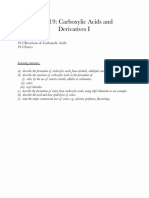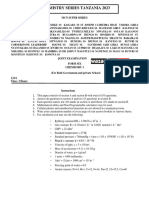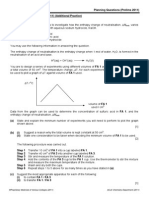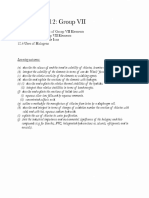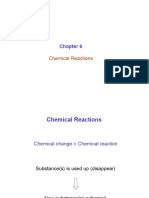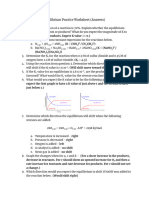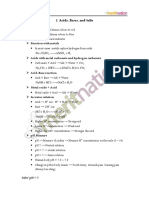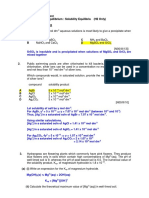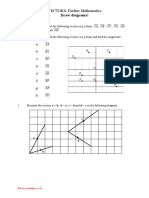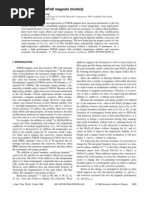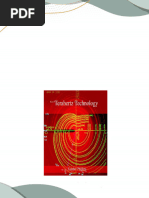A2 Test 11 Notes - Transition Elements
Uploaded by
will bellA2 Test 11 Notes - Transition Elements
Uploaded by
will bellTopic 5 Transition Elements
Revision Notes
1)
Introduction
2)
Electron arrangements
3)
The d-block is the ten short columns in the middle of the Periodic Table. All
of the elements in the d-block have their highest energy (outermost)
electron in a d sub-shell
Transition elements have 3 characteristic properties: they form coloured
ions, they have more than one oxidation state and they act as catalysts
To be a transition metal and display these properties, there must be at
least one ion that has an incomplete d sub-shell
This definition rules out Sc (whose only ion, Sc 3+, is 3d0) and Zn (whose
only ion, Zn2+, is 3d10). Sc and Zn are d-block elements but not transition
metals
Ions of transition elements undergo three types of reaction:
o Precipitation
o Ligand substitution
o Redox
The order in which electron orbitals are filled is as follows: 1s 2s 2p 3s 3p
4s 3d 4p
There are 2 exceptions to the pattern: chromium and copper
Cr is 1s2 2s2 2p6 3s2 3p6 4s1 3d5 and Cu is 1s2 2s2 2p6 3s2 3p6 4s1 3d10
These electronic structures are more stable than the alternative structures
that follow the pattern
When transition metals, like iron and copper, form ions they lose their 4s
electrons before their 3d electrons
Fe2+ is 1s2 2s2 2p6 3s2 3p6 4s0 3d6
(4s0 is optional)
2+
2
2
6
2
6
0
9
Cu is 1s 2s 2p 3s 3p 4s 3d
Illustration of Properties
a)
Variable oxidation state
The table below indicates the oxidation states of transition elements in
compounds
Source: http://commons.wikimedia.org/wiki/File:Transition_metal_oxidation_states.png
b)
c)
4)
Ti has oxidation state +4 in TiO2
V has oxidation state +5 in VO3- and +4 in VO2+
Cr has oxidation state +6 in K2Cr2O7 and +3 in CrCl3
Mn has oxidation state +4 in MnO2 and is +7 in KMnO4
Fe is +2 in FeSO4 and +3 in FeCl3. Co and Ni follow the same pattern
Cu is +1 in CuI and +2 in CuSO4
Formation of coloured ions
The dichromate(VI) ion, Cr2O72-, is orange and the chromate(VI) ion,
CrO4-, is yellow
The manganate(VII) ion, MnO4-, is purple
Cu2+(aq) is blue, Fe2+(aq) is pale green, Fe3+(aq) is yellow-brown, Co2+
(aq) is pink
Ability to act as catalysts
Transition elements and their compounds can act as catalysts
Fe is a heterogeneous catalyst in the Haber process, N2 + 3H2 2NH3
Ni is the catalyst for hydrogenation of alkenes e.g. CH2=CH2 + H2
CH3CH3
V2O5 is the catalyst in the Contact Process, 2SO2 + O2 2SO3, which is
one of the steps in the manufacture of sulphuric acid
Ligands and complex ions
a)
b)
Definitions
A complex consists of a central metal ion bonded to one or more
ligands e.g. [Fe(H2O)6]2+, [CuCl4]2Ligands have lone pairs of electrons e.g. H2O, Cl-, NH3, SCNLigands form co-ordinate bonds with the metal ion. The ligand is an
electron pair donor and the metal ion accepts an electron pair
Shapes
c)
With 6 ligands bonded to a metal ion, the complex is octahedral in
shape with a bond angle of 90
With 4 ligands bonded to a metal ion, the complex is usually
tetrahedral in shape with a bond angle of 109.5. The exceptions are
complexes of nickel and platinum which are square planar with a bond
angle of 90
Co-ordination number
The co-ordination number of a complex is the number of lone pairs
bonded to the central ion (not the number of ligands)
Unidentate ligands bond through one lone pair e.g. H2O, NH3, Cl-, SCN-,
CNBidentate ligands can form two bonds because they have two lone
pairs e.g. 1,2-diaminoethane, H2NCH2CH2NH2, which bonds through the
lone pairs on the nitrogen atoms
[Co(NH3)6]2+
Co-ordination number 6
(not 3)
Octahedral shape
[Pt(NH3)2Cl2]
Co-ordination number 4
Square planar shape
Source of these 4 diagrams:
d)
[Co(H2NCH2CH2NH2)3]2+
co-ordination number 6
octahedral shape
[CoCl4]2co-ordination number 4
tetrahedral shape
http://www.btinternet.com/~chemistry.diagrams/
Bond angles in ligands
In a water molecule, there are 2 bonding pairs and 2 lone pairs on the
oxygen atom. Lone pairs repel more than bonding pairs so the bond
angle is 104.5.
When water acts as a ligand, it has 1 lone pair and 3 bonding pairs. 1
lone pair repels less than 2 lone pairs so the bond angle is 107.
Similarly, in an ammonia molecule, the bond angle is 107 as there are
3 bonding pairs and 1 lone pair on the N.
e)
When ammonia acts as a ligand, there are 4 bonding pairs so the bond
angle is 109.5.
Naming complexes
The name of a complex gives the number and type of ligand and the
oxidation state of the transition element e.g.
[Cr(H2O)6]3+
waters
[Fe(CN)6]4cyanides
hexaaquachromium(III)
hexacyanoferrate(II)
Cr3+ bonded to 6
Fe2+ bonded to 6
f)
Cis-trans isomerism in complexes
Square planar complexes, such as [Ni(NH3)2Cl2], can show cis-trans
isomerism
cis-isomer
trans-isomer
Octahedral complexes, such as [Pt(NH3)4Cl2], can show cis-trans
isomerism because the chlorides can be at either 90 (cis) or 180
(trans)
both diagrams show the cis isomer
both diagrams show the trans
isomer
g)
Optical isomerism in complexes
Optical isomers are non-superimposable mirror images
Optical isomers rotate plane-polarised light in opposite directions by
the same number of degrees
Examples include [Co(H2NCH2CH2NH2)3]3+ which is abbreviated to
[Co(en)3]3+ in the following diagram
Source of this diagram:
http://www.tau.ac.il/chemistry/OnlineCourses/UrbakhLectures/complexes.pdf
h) Cis-platin
Cis-platin is an anti-cancer drug
It binds to DNA and prevents it from replicating
h) Haemoglobin
Porphyrin is a planar tetradentate ligand
Source: http://en.wikipedia.org/wiki/Porphyrin
When porphyrin forms four co-ordinate bonds with Fe2+, the resulting
complex is called haem
The iron achieves a co-ordination number of 6 by bonding to the protein
globin and to either an oxygen or water molecule. If the sixth bond is to
oxygen, the complex produced is oxyhaemoglobin. If the sixth bond is to
water the complex is deoxyhaemoglobin.
The oxygen bonds only weakly to the Fe2+. Carbon monoxide forms a much
stronger bond with Fe2+ and is therefore poisonous because it reduces the
oxygen carrying capacity of the blood
4) Precipitation reactions
When reacted with NaOH(aq), solutions of copper (II), cobalt (II), iron
(II) and iron (III) salts produce precipitates of the metal hydroxide
These reactions can be used as tests for Cu2+(aq), Co2+(aq), Fe2+(aq)
and Fe3+(aq)
Cu2+(aq) + 2OH-(aq) Cu(OH)2(s)
precipitate
Co2+(aq) + 2OH-(aq) Co(OH)2(s)
precipitate
Fe2+(aq) + 2OH-(aq) Fe(OH)2(s)
green ppt
Fe3+(aq) + 3OH-(aq) Fe(OH)3(s)
precipitate
5)
blue solution blue
pink solution blue
pale green solution
yellow solution orange
Ligand substitution reactions
In ligand substitution reactions, one ligand is displaced by a stronger
ligand.
a)
Copper(II) with ammonia solution
With excess concentrated NH3(aq) added dropwise, two reactions occur
Firstly, a precipitation reaction because ammonia solution contains
some OH-(aq) produced by the following reaction: NH3(aq) + H2O(l)
NH4+(aq) + OH-(aq)
[Cu(H2O)6]2+(aq) + 2OH-(aq)
Blue solution
Cu(OH)2(s) + 6H2O(l)
blue precipitate
With more ammonia, the blue precipitate dissolves to produce a dark
blue solution
Cu(OH)2(s) + 2H2O(l) + 4NH3(aq) [Cu(NH3)4(H2O)2]2+(aq) + 2OH(aq)
Blue precipitate
dark-blue solution
The overall reaction between copper(II) and ammonia is shown has
below. Ammonia has displaced water as a ligand
[Cu(H2O)6]2+(aq) + 4NH3(aq)
Blue solution
[Cu(NH3)4(H2O)2]2+(aq) + 4H2O(l)
dark blue solution
b) Copper(II) and cobalt (II) with concentrated HCl or saturated
NaCl(aq)
Concentrated HCl and saturated NaCl(aq) are sources of the chloride
ligand, ClWhen reacted with copper(II) solutions, chloride displaces water as a
ligand
[Cu(H2O)6]2+(aq) + 4Cl-(aq)
Blue solution
[CuCl4]2-(aq) + 6H2O(l)
yellow-green solution
[Co(H2O)6]2+(aq) + 4Cl-(aq)
Pink solution
[CoCl4]2-(aq) + 6H2O(l)
blue solution
c) Stability constants, Kstab
Expressions for stability constants, Kstab, can be written for ligand
substitution reactions e.g. for the reaction
[Fe(H2O)6]2+ + 6NH3 [Fe(NH3)6]2+ + 6H2O
Kstab expressions exclude the solvent (usually water). Note the double
square brackets for the complexes
Kstab =
[[Fe(NH3)6]2+]
[[Fe(H2O)6]2+] [NH3]6
A large value for Kstab indicates the formation of a more stable complex
ion. More stable complexes contain stronger dative bonds than less
stable complexes
6)
Redox reactions
a)
Constructing half-equations
Because transition elements have more than one oxidation state, they
undergo redox reactions.
Redox reactions can be split into two half-equations
Constructing simple half-equations involves two steps: balancing atoms
and balancing charge by adding electrons e.g. oxidation of iodide ions, I -,
to iodine, I2.
Write down formulae:
Balance atoms:
Balance charge:
I- I2
2I- I2
2I- I2 + 2e-
Constructing more complicated half-equations involves 2 extra steps,
namely: balancing oxygens by adding water and balancing hydrogens by
adding H+ e.g. oxidation of V2+ to VO3Write down formulae:
V2+ VO3Balance atoms (vanadiums):not needed
Balance oxygens:
V2+ + 3H2O VO3Balance hydrogens:
V2+ + 3H2O VO3- + 6H+
Balance charge:
V2+ + 3H2O VO3- + 6H+ +
3e
b)
Constructing overall equations
To produce the overall equation, multiply one or both half-equations
until the number of electrons is the same e.g. iron(II) and
manganate(VII)
Fe2+(aq) Fe3+(aq) + eMnO4-(aq) + 8H+(aq) + 5e- Mn2+(aq) + 4H2O(l)
In this case, multiply the first half-equation by 5 to get 5 electrons in
both.
5Fe2+(aq) 5Fe3+(aq) + 5e-
Now add the half-equations together, cancelling the electrons at the
same time.
5Fe2+(aq) + MnO4-(aq) + 8H+(aq) 5Fe3+(aq) + Mn2+(aq) +
4H2O(l)
c)
Any species that appears on both sides of the equation needs to be
cancelled e.g. H+
Redox titration calculations
As with acid-base reactions in Module 2811, redox reactions can be
used to determine unknown concentrations etc.
The method involves three steps:
Step 1
Calculate moles using concentration x volume/1000
Step 2
Use the redox equation to calculate moles of other chemical
Step 3
Use moles from step 2 to calculate unknown concentration
etc
Example A student takes 25.0 cm3 of aqueous hydrogen peroxide, H2O2,
and places this in a conical flask and then adds sulphuric acid to acidify the
hydrogen peroxide.
The student titrates this sample of acidified hydrogen peroxide against a
solution containing 0.0200 mol dm-3 MnO4-(aq) ions. For complete reaction
with the acidified hydrogen peroxide, the student used 17.5 cm 3 of this
solution containing MnO4-(aq) ions.
Calculate the concentration, in mol dm-3, of the aqueous hydrogen
peroxide. 2 mol MnO4- reacts with 5 mol H2O2.
Step 1 moles MnO4-
= conc x vol/1000
= 0.02 x 17.5/1000
= 3.5 x 10-4
Step 2 moles H2O2
= 3.5 x 10-4 x 5/2
= 8.75 x 10-4
Step 3 conc H2O2
= moles/volume
= 8.75 x 10-4/25 x 10-3
= 0.035 mol dm-3
Source:
d)
OCR paper January 2004
Estimation of copper in alloys
An alloy is a mixture of metals. Brass is an alloy of copper and zinc (about
60 to 70% copper). Bronze is an alloy of copper and tin
The percentage of copper in brass can be estimated by reaction with
iodide and titration of the iodine produced with thiosulphate, S 2O32Iodide ions reduce Cu2+ to Cu+
Cu2+ + I- Cu+ + I2
Cu+ then reacts with more iodide ions to form a precipitate of CuI
Cu+ + I- CuI
Overall:
Cu2+(aq) + 2I-(aq) CuI(s) + I2(aq)
White (but appears brown due to I2)
Brass is dissolved in nitric acid producing copper (II) nitrate and zinc
nitrate
An excess of potassium iodide, KI(aq), is added. This precipitates CuI(s)
and forms iodine, I2
The amount of iodine produced can be found by titration against sodium
thiosulphate, Na2S2O3
2S2O32- + I2 S4O62- + 2I-
Near the end-point, starch solution is added which produces a blue-black
colour with the remaining iodine
The end-point is when the blue-black colour just disappears
e)
Estimation of copper - example
A solution was prepared by dissolving some copper (II) sulphate to give
250 cm3 of aqueous solution
25.0 cm3 of this solution was treated with an excess of aqueous potassium
iodide, KI
2Cu2+(aq) + 4I-(aq) 2CuI(s) + I2(aq)
The iodine produced was titrated with 0.100 mol dm-3 sodium thiosulphate
I2(aq) + 2S2O32-(aq) 2I-(aq) + S4O62-(aq)
The average titre obtained was 22.0 cm3 of the thiosulphate solution
(a)
Calculate the amount of S2O32- ions in the titre
Moles S2O32-
(b)
Calculate the amount of I2 produced
Moles I2
(c)
= moles S2O32-/2
= 1.1 x 10-3 mol
Calculate the amount of Cu2+ ions in 25.0 cm3 of solution
Moles Cu2+
(d)
= conc x vol/1000
= 0.100 x 22.0/1000
= 2.2 x 10-3 mol
= moles I2 x 2
= 2.2 x 10-3 mol
Calculate the concentration of the aqueous copper (II) sulphate
solution in mol dm-3
Conc Cu2+
= moles/vol
= 2.2 x 10-3/(25.0/1000)
= 0.088 mol dm-3
You might also like
- London GCE O Level Syllabus D June1973-Jan1975No ratings yetLondon GCE O Level Syllabus D June1973-Jan197520 pages
- Hsslive-12. Aldehydes, Ketones & Carboxylic AcidsNo ratings yetHsslive-12. Aldehydes, Ketones & Carboxylic Acids12 pages
- Chapter 19 - Carboxylic Acids and Derivatives INo ratings yetChapter 19 - Carboxylic Acids and Derivatives I8 pages
- 12 Chemistry Impq CH08 D and F Block Elements 02No ratings yet12 Chemistry Impq CH08 D and F Block Elements 028 pages
- H432-01-Periodic Table, Elements and Physical Chemistry/a Level Chemistry A H432 - H432-01 - QS13No ratings yetH432-01-Periodic Table, Elements and Physical Chemistry/a Level Chemistry A H432 - H432-01 - QS135 pages
- Ionic Compound: History of Discovery Formation Bonding Structure PropertiesNo ratings yetIonic Compound: History of Discovery Formation Bonding Structure Properties12 pages
- Mass Spectrometry: Fragmentation: Ethers & Sulfides ! ! ! !No ratings yetMass Spectrometry: Fragmentation: Ethers & Sulfides ! ! ! !57 pages
- Organic Chemistry Reactions For H2 Chemistry, A-LevelsNo ratings yetOrganic Chemistry Reactions For H2 Chemistry, A-Levels4 pages
- Chemsheets As 008 (Amount of Substance)No ratings yetChemsheets As 008 (Amount of Substance)36 pages
- Lecture 9_Coordination Chemistry - structure and isomersNo ratings yetLecture 9_Coordination Chemistry - structure and isomers67 pages
- Acid Bases Salts and Reacting QuantitiesNo ratings yetAcid Bases Salts and Reacting Quantities11 pages
- Ionic Bonding 4. Bonding: Evidence For The Existence of IonsNo ratings yetIonic Bonding 4. Bonding: Evidence For The Existence of Ions9 pages
- Kinetics Revision Worksheet 2 (Solutions)No ratings yetKinetics Revision Worksheet 2 (Solutions)8 pages
- 2014 Entropy Tutorial With Solution For StudentsNo ratings yet2014 Entropy Tutorial With Solution For Students6 pages
- 09 - Ans To Solubility Eqm Supplemtary QN - 2012No ratings yet09 - Ans To Solubility Eqm Supplemtary QN - 20124 pages
- 2010 H2 Revision Package Organic Chem BT2 Solutions100% (1)2010 H2 Revision Package Organic Chem BT2 Solutions65 pages
- Alkanes: Alkanes Alkanes Alkenes Hydrocarbons As Fuels ArenesNo ratings yetAlkanes: Alkanes Alkanes Alkenes Hydrocarbons As Fuels Arenes23 pages
- Topic 5 - Transition Elements Revision Notes 1) : A) Variable Oxidation StateNo ratings yetTopic 5 - Transition Elements Revision Notes 1) : A) Variable Oxidation State10 pages
- NCERT Solutions Class 12 Chemistry Chapter 9 Coordination CompoundsNo ratings yetNCERT Solutions Class 12 Chemistry Chapter 9 Coordination Compounds21 pages
- NCERT Solutions For Class 12 Chemistry Chapter 9 Coordination CompoundsNo ratings yetNCERT Solutions For Class 12 Chemistry Chapter 9 Coordination Compounds23 pages
- Tranisition Elements-03 - Assignments (New)No ratings yetTranisition Elements-03 - Assignments (New)13 pages
- C4 Algebra - Rational Expressions & Partial Fractions 1 QPNo ratings yetC4 Algebra - Rational Expressions & Partial Fractions 1 QP3 pages
- Estimation of Extreme Wind Speeds: January 1995100% (1)Estimation of Extreme Wind Speeds: January 199516 pages
- Teaching Topics: Projectiles in M1: - Gun Shot, Canons, FireworksNo ratings yetTeaching Topics: Projectiles in M1: - Gun Shot, Canons, Fireworks5 pages
- XII Mathematics IIT JEE Advanced Study Package 2014 15 PDFNo ratings yetXII Mathematics IIT JEE Advanced Study Package 2014 15 PDF322 pages
- Exercises Iv:Atomic Absorbtion Spectroscopy (Aas)No ratings yetExercises Iv:Atomic Absorbtion Spectroscopy (Aas)17 pages
- Terahertz Technology 3rd Edition Xander Phillips all chapter instant download100% (2)Terahertz Technology 3rd Edition Xander Phillips all chapter instant download77 pages
- Theoretical Fluid Dynamics: Achim Feldmeier100% (1)Theoretical Fluid Dynamics: Achim Feldmeier579 pages
- Arnold - Ergodic Problems of Classical Mechanics50% (2)Arnold - Ergodic Problems of Classical Mechanics296 pages
- The University of Trinidad & Tobago: Final Assessment/Examinations July 2011No ratings yetThe University of Trinidad & Tobago: Final Assessment/Examinations July 20114 pages
- Resistencia de Materiales - N. M. Belyaev - Strength of Materials - MirNo ratings yetResistencia de Materiales - N. M. Belyaev - Strength of Materials - Mir650 pages
- 9702 Grade Booster-AS-Frequently Examined Questions FEQsNo ratings yet9702 Grade Booster-AS-Frequently Examined Questions FEQs20 pages
- Intso Stso Physics Class Vii Motion and Time Worksheet-7No ratings yetIntso Stso Physics Class Vii Motion and Time Worksheet-73 pages
- H432-01-Periodic Table, Elements and Physical Chemistry/a Level Chemistry A H432 - H432-01 - QS13H432-01-Periodic Table, Elements and Physical Chemistry/a Level Chemistry A H432 - H432-01 - QS13
- Ionic Compound: History of Discovery Formation Bonding Structure PropertiesIonic Compound: History of Discovery Formation Bonding Structure Properties
- Mass Spectrometry: Fragmentation: Ethers & Sulfides ! ! ! !Mass Spectrometry: Fragmentation: Ethers & Sulfides ! ! ! !
- Organic Chemistry Reactions For H2 Chemistry, A-LevelsOrganic Chemistry Reactions For H2 Chemistry, A-Levels
- Lecture 9_Coordination Chemistry - structure and isomersLecture 9_Coordination Chemistry - structure and isomers
- Ionic Bonding 4. Bonding: Evidence For The Existence of IonsIonic Bonding 4. Bonding: Evidence For The Existence of Ions
- 2010 H2 Revision Package Organic Chem BT2 Solutions2010 H2 Revision Package Organic Chem BT2 Solutions
- Alkanes: Alkanes Alkanes Alkenes Hydrocarbons As Fuels ArenesAlkanes: Alkanes Alkanes Alkenes Hydrocarbons As Fuels Arenes
- Exam Prep for:: Concepts in Transition Metal ChemistryFrom EverandExam Prep for:: Concepts in Transition Metal Chemistry
- Topic 5 - Transition Elements Revision Notes 1) : A) Variable Oxidation StateTopic 5 - Transition Elements Revision Notes 1) : A) Variable Oxidation State
- NCERT Solutions Class 12 Chemistry Chapter 9 Coordination CompoundsNCERT Solutions Class 12 Chemistry Chapter 9 Coordination Compounds
- NCERT Solutions For Class 12 Chemistry Chapter 9 Coordination CompoundsNCERT Solutions For Class 12 Chemistry Chapter 9 Coordination Compounds
- C4 Algebra - Rational Expressions & Partial Fractions 1 QPC4 Algebra - Rational Expressions & Partial Fractions 1 QP
- Teaching Topics: Projectiles in M1: - Gun Shot, Canons, FireworksTeaching Topics: Projectiles in M1: - Gun Shot, Canons, Fireworks
- XII Mathematics IIT JEE Advanced Study Package 2014 15 PDFXII Mathematics IIT JEE Advanced Study Package 2014 15 PDF
- Terahertz Technology 3rd Edition Xander Phillips all chapter instant downloadTerahertz Technology 3rd Edition Xander Phillips all chapter instant download
- The University of Trinidad & Tobago: Final Assessment/Examinations July 2011The University of Trinidad & Tobago: Final Assessment/Examinations July 2011
- Resistencia de Materiales - N. M. Belyaev - Strength of Materials - MirResistencia de Materiales - N. M. Belyaev - Strength of Materials - Mir
- 9702 Grade Booster-AS-Frequently Examined Questions FEQs9702 Grade Booster-AS-Frequently Examined Questions FEQs
- Intso Stso Physics Class Vii Motion and Time Worksheet-7Intso Stso Physics Class Vii Motion and Time Worksheet-7











